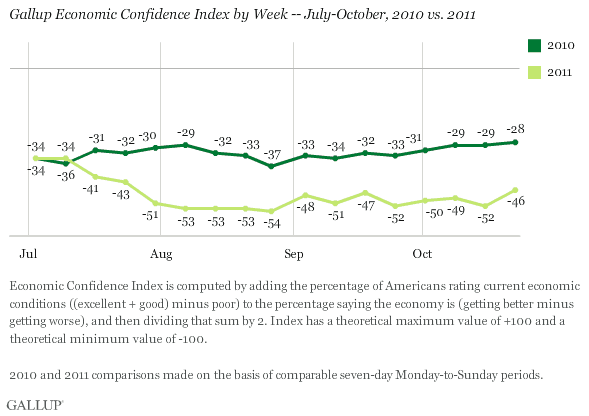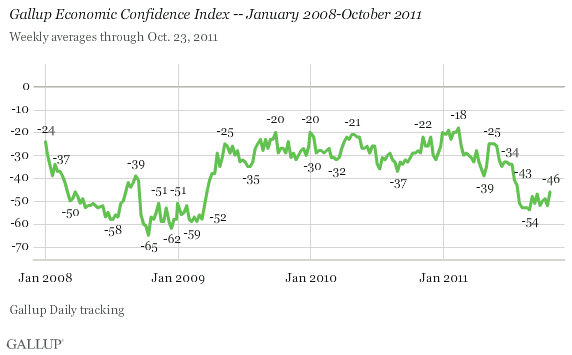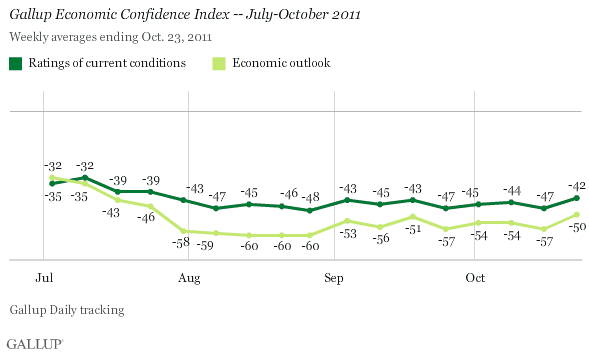PRINCETON, NJ -- Gallup's Economic Confidence Index rose to -46 last week, just above the -47 to -52 range seen since early September. More generally, Americans' confidence in the economy has been slightly better in September and October than in August after tumbling in July.

The latest weekly average is based on interviews conducted Oct. 17-23. Gallup measures Americans' economic confidence nightly as part of Gallup Daily tracking, and reports three-day rolling averages daily, in addition to weekly and monthly averages in Gallup's ongoing reporting.
Americans' confidence in the economy continues to track well below the levels seen during the same weeks in 2010. However, at -46, the current level is about midway between the record lows Gallup recorded during the U.S. financial crisis in late 2008/early 2009 and the modest recovery seen from about May 2009 through May 2011.

Current and Outlook Perceptions Re-Converge in Recent Weeks
Both components of the Gallup Economic Confidence Index -- Americans' ratings of current economic conditions and their perceptions of whether the economy is getting better or worse -- have been largely stable in October, but the values in the most recent week are the highest since late July.

Gallup Tracking Points to Slight Uptick in Conference Board Index in October
Changes in Gallup's Economic Confidence Index are strongly correlated with the monthly consumer indexes produced by the Conference Board and Thomson Reuters/University of Michigan. This is based on Gallup's analysis of its data from the first week of each month -- the period most comparable to the Conference Board's data-collection period and significantly overlapping the Thomson Reuters/University of Michigan field period.
Gallup's Economic Confidence Index for the first full week of each month rose from -53 in August to -51 in September and -49 October. On this basis, the Gallup trend points to a similarly slight increase in the Conference Board's October index, scheduled for release Tuesday morning. However, because the Conference Board is overdue for an increase from its August low, the increase could be on the order of three or more points.
The preliminary October Consumer Sentiment index issued a week and a half ago by Thomson Reuters/University of Michigan was 57.5 -- improved over its August 55.7 reading but below September's 59.4. If the preliminary reading is maintained in the final report, to be released Friday, the October decline may merely reflect a correction from the elevated September reading for that index.
Bottom Line
The Gallup Economic Confidence Index has shown some weekly variations in September and October, but at a consistently improved level over August. That trend was punctuated with a -46 reading in the past week, the most positive since late July. Still, the fundamental message from economic confidence data continues to be that consumers are weighed down by doubts about current economic conditions and the pace of recovery. While consumers are not nearly as positive (relatively speaking) as they were in the spring, they are perhaps recovering from the deep pessimism that set in two months ago.
Gallup.com reports results from these indexes in daily, weekly, and monthly averages and in Gallup.com stories. Complete trend data are always available to view and export in the following charts:
Daily: Employment, Economic Confidence and Job Creation, Consumer Spending
Weekly: Employment, Economic Confidence, Job Creation, Consumer Spending
Read more about Gallup's economic measures.
View our economic release schedule.
Survey Methods
Results are based on telephone interviews conducted as part of Gallup Daily tracking Oct. 17-23, 2011, with a random sample of 3,462 adults, aged 18 and older, living in all 50 U.S. states and the District of Columbia.
For results based on the total sample of national adults, one can say with 95% confidence that the maximum margin of sampling error is ±2 percentage points.
Interviews are conducted with respondents on landline telephones and cellular phones, with interviews conducted in Spanish for respondents who are primarily Spanish-speaking. Each sample includes a minimum quota of 400 cell phone respondents and 600 landline respondents per 1,000 national adults, with additional minimum quotas among landline respondents by region. Landline telephone numbers are chosen at random among listed telephone numbers. Cell phone numbers are selected using random-digit-dial methods. Landline respondents are chosen at random within each household on the basis of which member had the most recent birthday.
Samples are weighted by gender, age, race, Hispanic ethnicity, education, region, adults in the household, and phone status (cell phone only/landline only/both, cell phone mostly, and having an unlisted landline number). Demographic weighting targets are based on the March 2010 Current Population Survey figures for the aged 18 and older non-institutionalized population living in U.S. telephone households. All reported margins of sampling error include the computed design effects for weighting and sample design.
In addition to sampling error, question wording and practical difficulties in conducting surveys can introduce error or bias into the findings of public opinion polls.
For more details on Gallup's polling methodology, visit www.gallup.com.
